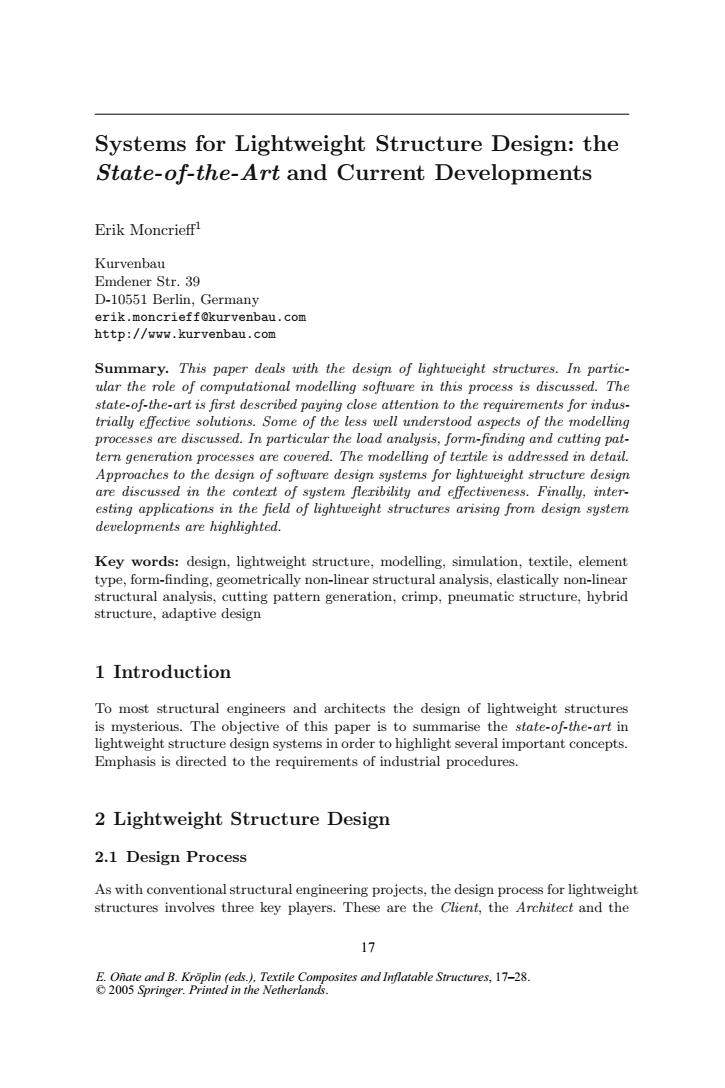正在加载图片...

Systems for Lightweight Structure Design:the State-of-the-Art and Current Developments Erik Moncrieff! Kurvenbau Emdener Str.39 D-10551 Berlin,Germany erik.moncrieff@kurvenbau.com http://www.kurvenbau.com Summary.This paper deals with the design of lightweight structures.In partic- ular the role of computational modelling software in this process is discussed.The state-of-the-art is first described paying close attention to the requirements for indus- trially effective solutions.Some of the less well understood aspects of the modelling processes are discussed.In particular the load analysis,form-finding and cutting pat- tern generation processes are covered.The modelling of tertile is addressed in detail. Approaches to the design of software design systems for lightweight structure design are discussed in the contert of system fleribility and effectiveness.Finally,inter- esting applications in the field of lightweight structures arising from design system developments are highlighted. Key words:design,lightweight structure,modelling,simulation,textile,element type,form-finding,geometrically non-linear structural analysis,elastically non-linear structural analysis,cutting pattern generation,crimp,pneumatic structure,hybrid structure,adaptive design 1 Introduction To most structural engineers and architects the design of lightweight structures is mysterious.The objective of this paper is to summarise the state-of-the-art in lightweight structure design systems in order to highlight several important concepts. Emphasis is directed to the requirements of industrial procedures. 2 Lightweight Structure Design 2.1 Design Process As with conventional structural engineering projects,the design process for lightweight structures involves three key players.These are the Client,the Architect and the 17 E.Onate and B.Kroplin (eds.).Textile Composites and Inflatable Structures,17-28. 2005 Springer.Printed in the Netherlands.Systems for Lightweight Structure Design: the State-of-the-Art and Current Developments Erik Moncrieff1 Kurvenbau Emdener Str. 39 D-10551 Berlin, Germany erik.moncrieff@kurvenbau.com http://www.kurvenbau.com Summary. This paper deals with the design of lightweight structures. In particular the role of computational modelling software in this process is discussed. The state-of-the-art is first described paying close attention to the requirements for industrially effective solutions. Some of the less well understood aspects of the modelling processes are discussed. In particular the load analysis, form-finding and cutting pattern generation processes are covered. The modelling of textile is addressed in detail. Approaches to the design of software design systems for lightweight structure design are discussed in the context of system flexibility and effectiveness. Finally, interesting applications in the field of lightweight structures arising from design system developments are highlighted. Key words: design, lightweight structure, modelling, simulation, textile, element type, form-finding, geometrically non-linear structural analysis, elastically non-linear structural analysis, cutting pattern generation, crimp, pneumatic structure, hybrid structure, adaptive design 1 Introduction To most structural engineers and architects the design of lightweight structures is mysterious. The objective of this paper is to summarise the state-of-the-art in lightweight structure design systems in order to highlight several important concepts. Emphasis is directed to the requirements of industrial procedures. 2 Lightweight Structure Design 2.1 Design Process As with conventional structural engineering projects, the design process for lightweight structures involves three key players. These are the Client, the Architect and the 17 E. Oñate and B. Kröplin (eds.), Textile Composites and Inflatable Structures, 17–28. © 2005 Springer. Printed in the Netherlands